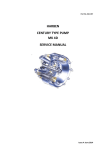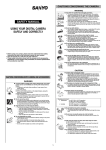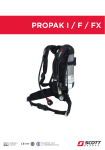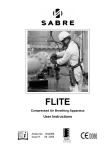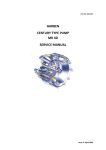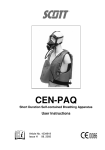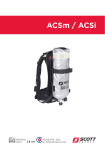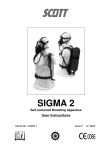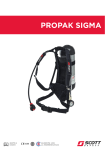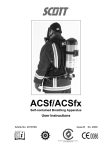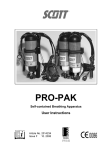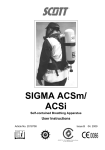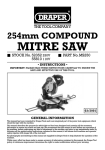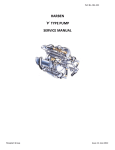Download FH1, FH2 & FH21 Cover
Transcript
FLITE CONFINED SPACE RESCUE COMPRESSED AIR BREATHING APPARATUS 1034990 D 05.2012 CE 0086 Contents WARNINGS ....................................................................................................................................... ii 1. INTRODUCTION ...................................................................................................................... 1 1.1 BREATHABLE AIR .......................................................................................................... 1 1.2 AIRLINE PRESSURE AND FLOW .................................................................................. 1 1.3 TRAINING ....................................................................................................................... 1 1.4 SERVICING .................................................................................................................... 2 1.5 PARTS AND ACCESSORIES ......................................................................................... 2 2. TECHNICAL DESCRIPTION.................................................................................................... 2 2.1 GENERAL ....................................................................................................................... 2 2.2 DEMAND VALVE ............................................................................................................ 2 2.3 HEADPIECES ................................................................................................................. 3 2.4 REDUCER / CYLINDER VALVE ..................................................................................... 3 2.5 CYLINDERS .................................................................................................................... 3 2.6 SAFETY HARNESS ........................................................................................................ 4 2.7 QUALITY ATTRIBUTES .................................................................................................. 4 3. PRE-USE CHECKS .................................................................................................................. 4 3.1 HEADPIECES ................................................................................................................. 4 3.2 JACKET AND HARNESS ................................................................................................ 5 4. DONNING AND OPERATING PROCEDURES........................................................................ 5 4.1 JACKET AND SAFETY HARNESS ................................................................................. 5 4.2 HEADPIECES ................................................................................................................. 6 4.2.1 Panaseal Facemask .............................................................................................. 6 4.2.2 ELSA Hood ............................................................................................................ 6 4.3 POSITIVE PRESSURE TEST ......................................................................................... 7 4.4 LEAK TEST ..................................................................................................................... 7 4.5 CYLINDER SUPPLY TEST ............................................................................................. 7 4.6 FROM AIRLINE TO CYLINDER ...................................................................................... 8 4.7 FROM CYLINDER TO AIRLINE ...................................................................................... 8 4.8 BYPASS .......................................................................................................................... 8 5. DOFFING THE APPARATUS .................................................................................................. 8 6. CLEANING AND SCHEDULED MAINTENANCE.................................................................... 9 6.1 FACEPIECES ................................................................................................................. 9 6.2 DEMAND VALVE .......................................................................................................... 10 6.3 JACKET AND HARNESS .............................................................................................. 10 6.4 REDUCER / CYLINDER VALVE AND CYLINDER ........................................................ 10 6.5 CHECK APPARATUS ................................................................................................... 10 6.6 DEMAND VALVE .......................................................................................................... 10 6.7 RECORD DETAILS OF CHECKS ................................................................................. 11 6.8 STORAGE..................................................................................................................... 11 6.9 MONTHLY MAINTENANCE .......................................................................................... 11 6.10 ANNUAL MAINTENANCE ............................................................................................. 11 Registered office: Scott Safety, Pimbo Road, West Pimbo, Skelmersdale, Lancashire, WN8 9RA, United Kingdom. i WARNINGS Please Read Carefully and Fully Understand This manual is for use by personnel trained in the use and care of compressed air breathing apparatus (BA) and MUST NOT be used as a self-teaching guide by untrained users. Failure to understand or adhere to these instructions may result in injury or death. Scott Safety have taken great care to ensure that the information contained within this manual is accurate, complete and clear. However, Training and Technical Support Services will be pleased to clarify any points in the manual and answer any questions on Scott Safety breathing apparatus. The following warnings are in accordance with certifying authority requirements and apply to the use of breathing apparatus in general: Breathing apparatus users must be fully trained in the use and care of airline and self-contained, compressed air breathing apparatus. Ensure that the selection of the apparatus type is sufficient for the tasks being undertaken and the hazards likely to be encountered. Please refer to National Regulations for guidance. In order to ensure optimum performance and user safety, the apparatus must be tested and serviced in accordance with Section 6 - Cleaning and Scheduled Maintenance and the notes in Section 1 - Training and Servicing. The quality of air used to supply and charge breathing apparatus must meet the requirements of EN 12021, Annex A. See Section 1 for details. The wearing of beards, side-burns or spectacles may adversely affect the sealing of a facemask to the wearer’s face. The apparatus is not approved for fire fighting or for use close to high heat sources. The apparatus must not be used underwater. DISCLAIMER Failure to comply with these instructions or misuse of the apparatus may result in death, injury or material damage and invalidate any resulting warranty or insurance claims. COPYRIGHT This manual must not be copied in part or in whole, or used for purposes other than it’s intended purpose without the written permission of Scott Safety. ii FLITE CSR 1.2 1. INTRODUCTION 1.1 BREATHABLE AIR Number of Wearers Air for compressed air breathing apparatus may be natural or synthetic. A typical composition of natural air is shown in Table 1. ELEMENT MASS % (Dry Air) 23.14 20.948 NITROGEN Supply Pressure bar (psi) Airflow (L/min) 1 5.5 – 9.5 (70 – 130) 300 2 (1 pair) 5.5 – 9.5 (70 – 130) 450 Table 2: Supply pressure and airflow VOLUME% (Dry Air) OXYGEN AIRLINE PRESSURE AND FLOW External air supplies must conform to the supply pressures and flow rates listed in Table 2 when measured at the wearer end of the airline. 75.52 78.08 ARGON 1.29 0.93 CARBON DIOXIDE 0.05 0.031 4 HYDROGEN 0.000 003 0.000 05 NEON 0.001 270 0.001 818 1.3 Personnel who use self-contained, compressed air breathing apparatus must be fully trained in accordance with these instructions and national regulations. HELIUM 0.000 037 0.000 524 KRYPTON 0.000 330 0.000 114 XENON 0.000 039 0.000 009 An airline flow tester is available from Scott Safety under Article Number 1035978. Table 1: Breathable Air TRAINING These instructions cannot replace an accredited training course run by fully qualified instructors in the proper and safe use of Scott Safety breathing apparatus. There is an increased fire risk when the oxygen content is above the value shown in Table 1. The purity/quality of air used to supply and charge breathing apparatus must conform to European Standard EN 12021. Please contact Training and Technical Support Services or your Scott Safety distributor for training course details. Training and Technical Support Services: Contaminants must be kept to a minimum and must not exceed permissible exposure levels. Scott Safety Pimbo Road, West Pimbo, Skelmersdale, Lancashire, WN8 9RA, United Kingdom. Air filters must be suitable for the quality of air used and the air must be tested periodically to ensure that the supply reaches these standards. The air must be free from the odour of oil. The odour 3 threshold is 0.3mg/m . Tel: +44 (0) 1695 711711 Fax: +44 (0) 1695 711775 Air for use with compressed air airlines should have a dew point sufficiently low to prevent internal freezing. National Regulations for compressed airline breathing apparatus must be observed. 1 FLITE CSR 1.4 SERVICING 2. TECHNICAL DESCRIPTION FLITE Confined Space Rescue (CSR) must be serviced at scheduled intervals by personnel who have completed a formal training course and hold a current certificate for servicing and repairing Scott Safety breathing apparatus. Details of the Servicing Schedule are contained within the Scott Safety FLITE Service Manual, copies of which may only be obtained by registered holders of a current certificate. 2.1 Non-return valves in the airline connector and cylinder connector permit the apparatus to be used without a cylinder OR without the airline. Your Scott Safety distributor or Training and Technical Support Services at Scott Safety will be pleased to provide training course details and quotes for service contract. Please see above for contact details. 1.5 GENERAL FLITE CSR is a self-contained, open circuit, compressed air, positive pressure breathing apparatus with a safety harness. An airline version permits the wearer to disconnect the airline while in a hazard area and breathe from the compressed air cylinder. A carbon fibre/aluminium cylinder should be used with apparatus that is to be used for full shift periods. A steel cylinder should NOT be used for full shift working. PARTS AND ACCESSORIES The breathing apparatus comprises a full facemask or hood, a demand valve and a pigtail with CEN connector for attaching to the supply airline. There are two cylinder options that can be provided with the apparatus. Customer Services provide an efficient, friendly customer contact point for ordering new apparatus, spare parts and accessories. Customer Services: Providing the apparatus is serviced regularly in accordance with the service requirements detailed in the FLITE Service Manual, there are no shelf life limits. Scott Safety Pimbo Road, West Pimbo, Skelmersdale, Lancashire, WN8 9RA, United Kingdom. Tel: +44 (0) 1695 711711 Fax: +44 (0) 1695 711775 2.2 DEMAND VALVE Airflow into the headpiece is controlled by the demand valve, which is attached to the headpiece by a quick-fit connection. 2 FLITE CSR The demand valve can be closed by the wearer pressing a reset button to enable the headpiece to be removed without loss of compressed air to the atmosphere. 2.4 The reducer/cylinder valve is a spring and piston device with a handwheel to open/close the cylinder valve. When the demand valve is next used, the first breath taken by the wearer opens the demand valve. The pressure output to the headpiece demand valve is between 5 and 11 bar. Protection from over-pressurisation is provided by a pressure relief valve that operates at 11.5 bar. The bypass knob enables an unregulated flow of compressed air into the headpiece to protect the user in the event of the demand valve failing in a ‘no flow’ condition. 2.3 REDUCER / CYLINDER VALVE A pressure gauge indicates the cylinder pressure. The red sector on the gauge indicates when the cylinder is almost empty. HEADPIECES Headpieces are stored in a bag attached to the jacket. The bag has a pictogram of the donning procedure. When the cylinder is opened, air flows through the reducer to the demand valve. WARNING: As the donning procedure is specific to the headpiece type, it is important that after use, facemasks are replaced in facemask bags and hoods in hood bags. 2.5 CYLINDERS The following cylinders are approved for use with FLITE: 10 minute cylinder: There are two types of positive pressure headpieces available with FLITE CSR: PanaSeal or ELSA Hood; both have: • An ori-nasal inner mask to minimise carbon dioxide dead space and prevent visor misting. • A speech diaphragm that reduces wearer speech distortion. • A spring-loaded exhale valve that limits the positive pressure within the headpiece. • Breathing apparatus bayonet demand valve fitting. Free air capacity: 400 litres Charging pressure: 200 bar Material: Alloy Steel Specification: CE PanaSeal is a positive pressure, full facemask that is held in place by a fivepoint adjustable head harness and a left, quick-fit demand valve. The polycarbonate visor conforms to BS2092 Grade 1 for impact and optical clarity. Duration at 40 L/min: 10 minutes Weight (charged): 5.5 Kg 13 minute cylinder: Free air capacity: 540 litres Charging pressure: 300 bar Material: Carbon Fibre / Aluminium Specification: CE Duration at 40 L/min: 13 minutes Weight (charged): 4.3 Kg When the supply airline is disconnected, a non-return valve in the supply airline protects the airline from contamination whilst a second non-return valve in the FLITE pigtail hose prevents air loss from the cylinder supply. ELSA Hood is a full hood that fits most head sizes. It has an elasticated neck seal and a front-fitting demand valve. When FLITE is used with an airline supply and the cylinder is disconnected, a non-return valve in the cylinder hose prevents loss of air. 3 FLITE CSR 2.6 SAFETY HARNESS 3. PRE-USE CHECKS The safety harness is sewn into a highvisibility jacket and is approved for use with personnel weighing up to 100 Kg. 3.1 HEADPIECES 1. Remove headpiece from its bag. Peel the Visorguard protective film from the facemask and store carefully for use later. The safety line attachment point, located between the wearer’s shoulders, is capable of accepting connectors of up to 25mm diameter. 2. Check that the mask/hood is clean and the visor is clear and undamaged. Slacken the facemask head harness. The harness is fully adjustable. A harness tail with a D-ring provides an attachment point for the pigtail and relieves the pull of the airline hose. The harness also supports the cylinder bag and headpiece bag. The high-visibility jacket reduces the possibility of the apparatus snagging. It has stowage points for a radio, Firefly ASDU and a Minigas gas detector. 2.7 QUALITY ATTRIBUTES FLITE CSR is approved to the following European Standards: • EN 139 : 1993 (Respiratory Protective Devices – Compressed Airline Breathing Apparatus). • EN 402 : 1993 (Respiratory Protective Devices for Escape). 3. Pull the locking catch, turn the demand valve clockwise and withdraw it from the headpiece. FLITE CSR is ‘CE’ marked in accordance with EEC Directive EC/686/1986. The safety harness is approved to BS EN 361 : 1993 and is also ‘CE’ marked. Scott Safety Breathing Apparatus is an ISO9001 (BS5750 Pt 1) approved Division of Scott Safety. 2.8 NOTIFIED BODIES Inspec International Limited (No. 0194) 56 Leslie Hough Way, Salford, Greater Manchester, M6 6AJ, England. 4. Check that the orange O-ring on the demand valve is in good condition and attach the demand valve to the facemask. BSI (0086) Kitemark Court, Davy Ave, Knowlhill, Milton Keynes, MK5 8PP. England. 5. Twist the demand valve gently to check that the locking catch is engaged. 4 FLITE CSR 6. Check that the bypass knob is in the OFF position and press the black rubber reset button on the demand valve. 3.2 4. DONNING AND OPERATING PROCEDURES JACKET AND HARNESS 1. Fully slacken the shoulder straps and leg strap. 4.1 waistbelt, JACKET AND SAFETY HARNESS 1. Don the jacket and safety harness so that the demand valve hose is on the right shoulder and the cylinder is on the left hip. 2. Tighten the shoulder straps for a secure, comfortable fit. 2. Check that the pigtail shackle is attached to the D-ring and that the shackle nut is fully tightened. 3. Check that the cylinder is full and held securely in it’s bag. 3. Fasten the waist-belt and leg strap. 4. Remove the pigtail connector dust cap. Check that the connector is clean and in good condition. Check that there is no damage or excess wear to the harness. 5. Replace any items that are damaged or show signs of excessive wear. DO NOT use equipment that fails any of the above checks. 4. Remove the pigtail coupling dust cap. Check that the connector is clean and in good condition. 6. Check the airline supply hose for wear or damage. Check the quality and pressure of the external supply air. 5 FLITE CSR 5. Press the demand valve reset button and connect the pigtail to the airline. Pull the airline to ensure that the coupling is securely connected. 4.2 4.2.1 4. Tighten the head harness straps in the following sequence: bottom, middle, top. DO NOT OVER-TIGHTEN. 5. Take a sharp breath to actuate the first breath mechanism. HEADPIECES 4.2.2 Panaseal Facemask 1. 1. Withdraw the facemask from its bag. Remove the Visorguard and store in the facemask bag. ELSA Hood Withdraw the hood from its bag. 2. Insert hands, palms together, into the hood and stretch the elasticated neck seal. Pull the hood over the back of the head and then over the face. 2. Hang the facemask from the neckstrap and attach the demand valve. Twist demand valve gently to ensure that it is securely attached. 3. Fit the chin into the chin-cup and pull the head harness over the back of the head, ensuring that no hair is trapped under the face seal. 6 FLITE CSR 4.4 LEAK TEST 1. Hold your carefully for leaks. breath and listen 2. If a leak is detected, adjust the facemask and head harness or hood neck-seal. Repeat the test. If the leak is still present, the apparatus must be returned for repair. 4.5 CYLINDER SUPPLY TEST 3. Check that the inner mask fits properly over the mouth and nose. Inhale sharply to activate the first breath mechanism. 4.3 POSITIVE PRESSURE TEST 1. Open the cylinder valve. 1. Take a deep breath to activate the first breath mechanism. 2. Gently insert fingers into the facemask seal or hood neck-seal and check that there is a good flow of air from the headpiece. 2. Push the CEN coupling together, pull back the airline connector collar and release the airline. 3. Remove fingers from the seal and allow the mask/hood to re-seal. 3. Check that there is a plentiful supply of air into the face-piece. 4. DO NOT use an apparatus that fails this test. 5. If no leaks are detected, the apparatus is ready for use. 7 FLITE CSR 4.6 FROM AIRLINE TO CYLINDER 5. DOFFING THE APPARATUS 1. Check the cylinder gauge to ensure that there is sufficient air. Open cylinder valve. WARNING: DO NOT remove the apparatus until well clear of the hazard area. 2. Push the airline couplings together and pull back the CEN collar to disconnect the hose from the pigtail. 4.7 1. Take a deep breath, press the demand valve reset button. FROM CYLINDER TO AIRLINE 1. Connect the airline to the pigtail and close the cylinder valve. WARNING: If the cylinder valve is not closed, the cylinder will empty. 4.8 BYPASS 1. In the unlikely event that the demand valve stops delivering air while in a hazard area, open the demand valve bypass knob. 2. Leave immediately. the hazard area 2. Release the headpiece: PanaSeal Pull the harness buckles forward in the following sequence: bottom, middle, top. Remove the facemask. ELSA Hood Slip thumbs inside the neck-seal and pull off the hood. WARNING: Using the bypass reduces the supply duration of the cylinder. 3. If you have been breathing from the cylinder, close the cylinder valve. 8 FLITE CSR 6. CLEANING AND SCHEDULED MAINTENANCE 6.1 FACEPIECES Cautions: • DO NOT allow water to enter the demand valve. Fit the yellow dust cap to the demand valve. • Use ONLY specified substances and methods to clean the apparatus. • DRY THOROUGHLY before storage. 1. Pull the red release catch and disconnect the demand valve. 4. Push the airline couplings together and pull back the CEN collar to disconnect the hose from the pigtail. 2. Wash the headpiece in a hand-hot solution of DistelTM and water. 5. Open the demand valve bypass to vent any compressed air from the system. 3. Rinse thoroughly in clean running water, paying particular attention to the exhale valve. 4. Dry thoroughly at room temperature. DO NOT expose to high temperatures or direct sunlight. 5. When dry, wipe the facemask seal with a DistelTM disinfectant wipe. 6. Check that the inhale valve flaps are not damaged or distorted. 7. When the headpiece is dry, polish the visor with a soft, clean, lint-free cloth. Replace the PanaSeal Visorguard (Article Number 1031836). Slacken the facemask head harness ready for use. 8. Stow headpiece in the stowage bag provided. 6. Fit the dust cap on the CEN pigtail coupling. Notes: DistelTM cleansing and disinfecting fluid is available in 1 litre and 5 litre containers from Scott Safety under Article Numbers 2008247 and 2008248 respectively. 7. Release the waist-belt and leg strap. Remove the apparatus. 8. Clean and check the apparatus in accordance with Section 6 – Cleaning and Scheduled Maintenance before returning it to service. Pump dispensers suitable for use with the above are also available under Article Numbers 1017672 (1 litre) and 1017670 (5 litres). DistelTM disinfecting wipes are available in packs of 20 sachets (Article Number 2004225) or drums of 100 wipes (Article Number 1017652). 9 FLITE CSR 6.2 DEMAND VALVE 6.5 CHECK APPARATUS 1. Check the apparatus thoroughly for signs of damage and wear. If any of the components are damaged or worn, the apparatus (together with an explanatory note) must be returned for servicing. 2. Check that the cylinder valve handwheel turns smoothly and does not stick. 3. Check that the cylinder is full. If it is not, the equipment must be withdrawn from service for the cylinder to be recharged. 6.6 DEMAND VALVE 1. Fit the yellow dust cap (Article Number 1033545) over the demand valve inlet. Immerse the bypass knob in running water and operate the bypass knob several times. 2. Clean the outer surfaces with a clean, lint-free cloth. Persistent marks can be removed with a clean, lint-free cloth moistened with a solution of DistelTM and warm water. 3. Check that the locking catch and the bypass knob move freely. If either does not move freely, the demand valve must be serviced. 6.3 1. Operate the locking catch several times to check that it does not stick. The locking catch should spring back to it’s original position without sticking. JACKET AND HARNESS 1. Brush dirt from the jacket and harness using a stiff nylon-bristled brush (nail brush or similar). 2. Operate the bypass knob several times and check that it does not stick and, when it is released, always rests in the ON or OFF position. 2. If it is heavily soiled, it can be soaked in a solution of DistelTM and warm water for one hour and then scrubbed with the brush. 3. Check that the demand valve Oring is in good condition. 3. Dry thoroughly in a well-ventilated room, away from direct heat and sunlight. 6.4 REDUCER / CYLINDER VALVE AND CYLINDER 1. Dust the exterior of the equipment with a clean, lint-free cloth. 2. Use a lint-free cloth moistened in DistelTM to clean off persistent marks. 3. full. Charge cylinders that are less than 10 FLITE CSR 6.7 RECORD DETAILS OF CHECKS 6.8 STORAGE Device must be protected from damage during transportation. After use, store in a cool, clean, dry environment away from excessive heat or sunlight. In the UK it is a statutory requirement of the Control of Substances Hazardous to Health (CoSHH) Regulations and the Personal Protective Equipment (PPE) directive, that a Log is maintained for each apparatus to enable users to record the results of Apparatus Checks (as described above) and all other service procedures and repairs. The Log must be available for examination. 6.9 MONTHLY MAINTENANCE The apparatus must be checked monthly, in accordance with the instructions for the Pre-Use Checks. A Breathing Apparatus Logbook is available from Scott Safety under Article Number 1034745 for this purpose. Details of these tests must be recorded in the appropriate register and retained for future reference. The Log Book should contain: • Name and address of the employer responsible for the apparatus. • Name and signature, or unique authentication, of the person conducting the test. • Manufacturer, model and serial number of the equipment, together with details of any other distinguishing features or markings that aid identification. • Condition of the equipment and details of any faults found during the tests, including details of any remedial action taken. • Air pressure within the cylinder. • The quantity of flow and quality of air supplied by any airline system or systems used with the apparatus. • Types of test conducted • Date of the test. In the United Kingdom, monthly testing is a statutory requirement of the Control of Substances Hazardous to Health (CoSHH) Regulations and the Personal Protective Equipment (PPE) Directive. 6.10 ANNUAL MAINTENANCE The apparatus must be tested and serviced in accordance with the FLITE Service Schedule within a maximum period of one year. Full details of this testing and servicing can be found in the FLITE Service Manual, which is available from Training and Technical Support Services at Scott Safety upon completion of formal apparatus maintenance training. If the apparatus is used frequently it may be necessary to replace components on a more frequent basis than stipulated. 11 Scott Safety Pimbo Road, West Pimbo, Skelmersdale, Lancashire, WN8 9RA, England www.scottsafety.com [email protected] Tel: +44 (0) 1695 711711 Fax: +44 (0) 1695 711775 English (GB) © 2011 Scott Safety. All rights reserved. SCOTT, the SCOTT SAFETY Logo, Scott Health and Safety, Flite CSR are registered and/or unregistered marks of Scott Technologies, Inc. or its affiliates.















